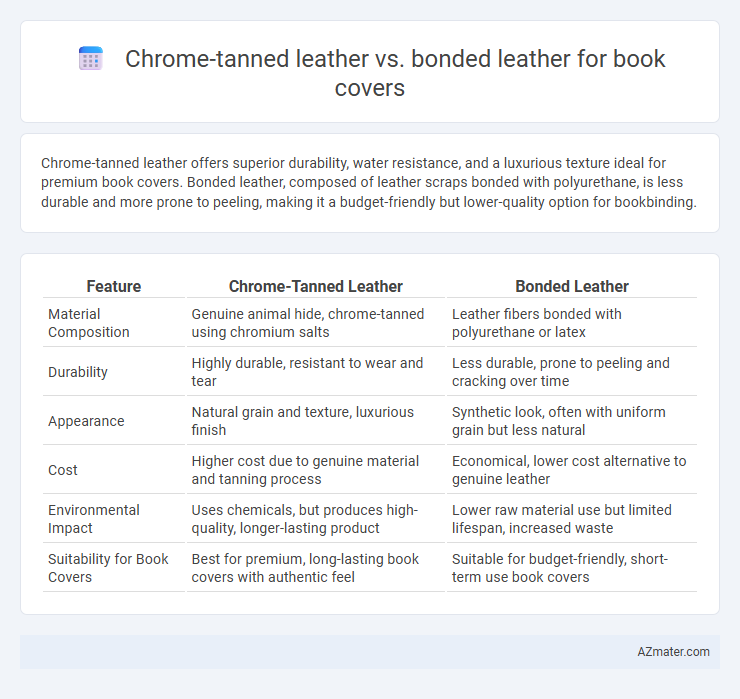Chrome-tanned leather offers superior durability, water resistance, and a luxurious texture ideal for premium book covers. Bonded leather, composed of leather scraps bonded with polyurethane, is less durable and more prone to peeling, making it a budget-friendly but lower-quality option for bookbinding.
Table of Comparison
| Feature | Chrome-Tanned Leather | Bonded Leather |
|---|---|---|
| Material Composition | Genuine animal hide, chrome-tanned using chromium salts | Leather fibers bonded with polyurethane or latex |
| Durability | Highly durable, resistant to wear and tear | Less durable, prone to peeling and cracking over time |
| Appearance | Natural grain and texture, luxurious finish | Synthetic look, often with uniform grain but less natural |
| Cost | Higher cost due to genuine material and tanning process | Economical, lower cost alternative to genuine leather |
| Environmental Impact | Uses chemicals, but produces high-quality, longer-lasting product | Lower raw material use but limited lifespan, increased waste |
| Suitability for Book Covers | Best for premium, long-lasting book covers with authentic feel | Suitable for budget-friendly, short-term use book covers |
Introduction to Book Cover Materials
Chrome-tanned leather is a popular book cover material known for its durability, flexibility, and resistance to moisture due to the chromium salts used in the tanning process. Bonded leather, on the other hand, is made by combining shredded leather fibers with polyurethane or latex, offering a more affordable but less durable alternative with a synthetic feel. For book covers, chrome-tanned leather provides a premium, long-lasting finish, while bonded leather suits budget-conscious projects requiring a leather-like appearance.
What is Chrome-Tanned Leather?
Chrome-tanned leather is processed using chromium salts, primarily chromium sulfate, which speeds up tanning and enhances leather durability, softness, and water resistance. This type of leather maintains natural grain and flexibility, making it ideal for premium book covers requiring longevity and a refined texture. In contrast, bonded leather consists of leather scraps adhered together with polyurethane or latex, offering a less durable and lower-quality alternative.
What is Bonded Leather?
Bonded leather is a material composed of shredded leather fibers mixed with a polyurethane or latex binder, pressed onto a fiber backing to create a uniform surface. It offers a cost-effective alternative to genuine leather but lacks the durability, breathability, and rich texture found in chrome-tanned leather. Chrome-tanned leather, treated with chromium salts, provides superior flexibility, water resistance, and longevity, making it a preferred choice for high-quality book covers.
Appearance and Texture Comparison
Chrome-tanned leather used for book covers offers a smooth, supple texture with natural grain patterns that enhance visual richness and durability. Bonded leather, made from leather scraps bonded with polyurethane, often presents an artificial, uniform appearance and a synthetic feel lacking the authentic texture of genuine leather. The superior flexibility and refined finish of chrome-tanned leather provide a luxurious tactile experience compared to the stiffer, less resilient surface typical of bonded leather covers.
Durability and Longevity
Chrome-tanned leather offers superior durability and longevity for book covers due to its resistance to cracking, fading, and water damage, making it ideal for frequent handling and long-term use. Bonded leather, composed of leather scraps bonded with polyurethane or latex, tends to wear out faster, exhibiting peeling and cracking within a few years. Choosing chrome-tanned leather ensures enhanced protection and maintains aesthetic quality over time, outperforming bonded leather in longevity and durability.
Cost and Affordability Analysis
Chrome-tanned leather offers superior durability and a premium finish, typically costing between $20 to $50 per square foot, making it a higher investment for book covers. Bonded leather, composed of leather scraps bonded with polyurethane, ranges from $5 to $15 per square foot, providing a cost-effective alternative with less longevity. The affordability of bonded leather makes it popular for budget-conscious projects, while chrome-tanned leather is preferred for long-lasting, high-quality book covers.
Environmental Impact
Chrome-tanned leather involves chemical processes using chromium salts, leading to significant environmental concerns due to hazardous waste and water pollution. Bonded leather, made from leather scraps bonded with polyurethane or latex, has a lower environmental footprint by recycling leather remnants but often includes synthetic materials that are less biodegradable. Choosing bonded leather for book covers reduces toxic waste compared to chrome-tanned leather, supporting more sustainable production practices.
Customization and Design Flexibility
Chrome-tanned leather offers superior customization and design flexibility for book covers due to its consistent texture, durability, and ability to absorb dyes evenly, allowing for vibrant colors and intricate embossing. Bonded leather, composed of leather scraps mixed with synthetic materials, is less adaptable to detailed customization and may exhibit inconsistencies in color and texture, limiting design options. The enhanced pliability and strength of chrome-tanned leather support a wider range of decorative techniques, making it the preferred choice for bespoke, high-quality book covers.
Maintenance and Care Requirements
Chrome-tanned leather offers superior durability and requires less frequent conditioning to maintain its suppleness and appearance, making it ideal for long-lasting book covers. Bonded leather, composed of leather scraps bonded with polyurethane or latex, demands gentler cleaning methods and more frequent care to prevent peeling and cracking. Proper maintenance of chrome-tanned leather includes wiping with a damp cloth and using specialized leather conditioners, whereas bonded leather benefits from light dusting and avoiding excessive moisture to extend its lifespan.
Which Leather is Best for Book Covers?
Chrome-tanned leather offers superior durability, flexibility, and a luxurious finish, making it ideal for premium book covers that require long-lasting protection and aesthetic appeal. Bonded leather, often made from leftover leather fibers bonded with polyurethane, provides a more affordable option but lacks the strength and natural texture of genuine tanned leather, leading to quicker wear and less elegance. For book covers, chrome-tanned leather is generally the best choice due to its resilience, rich feel, and ability to age gracefully over time.

Infographic: Chrome-tanned leather vs Bonded leather for Book cover
 azmater.com
azmater.com